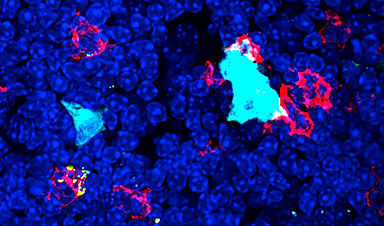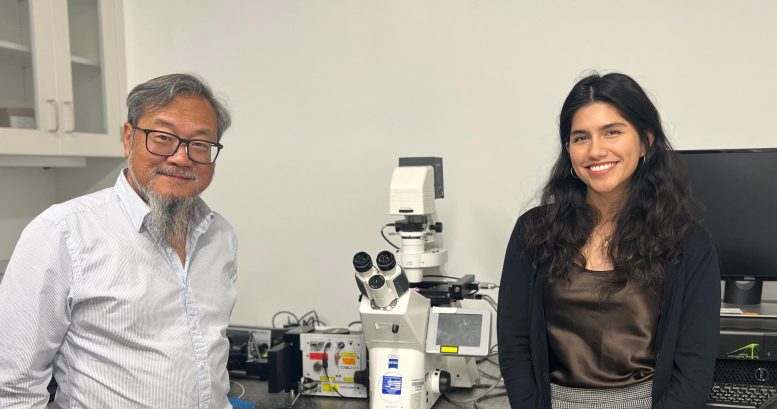Biomedical scientists from UC Riverside state that the cells resemble M cells found in the gut and airways.
It came as a surprise to Professor David Lo and his graduate student Diana Del Castillo when they were recently consulted by researchers in Israel for their expertise on specialized cells called Microfold cells, or M cells, which are mostly known for their presence in the intestinal epithelium. The Israeli group had identified similar cells in the thymus, an organ located just above the heart that makes lymphocytes — white blood cells that play an important role in the immune system and protect the body against infection.
Lo, a distinguished professor of biomedical sciences in the UC Riverside School of Medicine, and Del Castillo, who are co-authors on the research paper published in Nature, confirmed the newly discovered cells in the thymus are just like M cells. Acting like gatekeepers, M cells are specialized antigen-delivery cells for the immune system in organs like the intestine and lungs. They play a key role in the development of the body’s immune system.
The researchers at the Weizmann Institute of Science in Israel, led by Jakub Abramson, initiated the mouse study on the thymic epithelium before contacting Lo, whose research interests include understanding how M cells in the gut and airways work to build our immune system.
“I have been working on these cells for several years, so when the Israeli team contacted me, I was intrigued,” Lo said. “I learned this group had been doing studies on the cellular architecture of stromal cells — cells that make up certain types of connective tissue — in the thymus and, using a new advanced method, had discovered a population of cells much like the M cells we see in the gut and airways. In my own research, I had simply never thought to look for M cells in the thymus.”
Fortuitously for the Israeli scientists, Del Castillo, under Lo’s guidance, had been studying mucosal tissues — tissues that line some of the body’s canals and organs — in mice in the lab and was able to answer several questions, such as where in the thymus the newly discovered cells are located and what they are doing there.
The Unique Nature of Thymic M Cells
“These particular M cells are limited to a specific region in the thymus and have unique associations with different cell types and functions,” Del Castillo said. “Questions these cells have already prompted include how similar are they to M cells elsewhere in the body and what is different about where they have been found.”
Lo explained that for many years the thymus has been a tissue of interest to immunologists because most of the immune system’s development is centered and dependent on the thymus.
“It’s still an ongoing deep puzzle that continues to attract interest,” he said. “The thymus offers clues to how the immune system got its start. This complicated organ, with so many different stromal cell types and interactions, is responsible for producing lymphocytes that protect us from infection.”
According to Lo, the newly discovered M cells are extremely similar to the M cells seen in the gut and airways.
“But the thymic M cells have different developmental origins, which is an interesting puzzle in itself,” he said. “After they develop, they look very much like the ones we have been studying in the gut. As we know, M cells capture viruses and bugs that enter the airways and hand them off to the immune system, which then responds to the infectious agents. Are the M cells doing the same thing in the thymus in terms of organization and function? That’s what we would like to know.”
Exploring the Function of Thymic M Cells
Del Castillo, who is working toward her doctoral degree in biomedical sciences, used genetically engineered mice to tackle the questions from the Israeli researchers.
“We found the new cells were scattered in the medullary region of the thymus,” she said. “This has interesting implications in terms of the role and compartmentalization of the thymus, such as how these cells may function to regulate lymphocyte training within this organ.”
Lo and Del Castillo were surprised to find that many steps involved in shaping an immune response in various parts of the body seem to be echoed in the thymus.
“It is fascinating to see that many of these early cell interactions and development we have studied closely in the peripheral immune system take place in the thymus,” Lo said. “We had not anticipated to see these interactions here. It’s like watching a short video in the thymus about what is happening big-scale out in the periphery.”
The thymus also ensures that lymphocytes do not accidentally attack our own tissues; the thymic medulla is where these decisions are made, the UCR scientists said.
“The newly discovered M cells are part of this decision-making process,” Del Castillo said. “The production of antibodies in the peripheral immune system to fight off infectious organisms involves several steps and many cells interacting with each other. What is fascinating is that some of these interactions are recapitulated in the early stages of the development of the thymic M cells.”
According to Lo, the thymic M cells could be seen as being trained to function later, when needed, in the periphery in such a way that they are ready to communicate and interact with other cells.
“The thymus is complicated because it creates a whole functional immune system and repertoire, and we know many component parts play a role in its performance,” he said. “We didn’t expect M cells to even show up in the thymus. This is, therefore, a satisfying discovery because it is so clearly connected to similar processes happening in the gut and airways, which is where 60-70% of our infectious agents enter our bodies.”
Reference: “Thymic mimetic cells function beyond self-tolerance” by Tal Givony, Dena Leshkowitz, Diana Del Castillo, Shir Nevo, Noam Kadouri, Bareket Dassa, Yael Gruper, Razi Khalaila, Osher Ben-Nun, Tom Gome, Jan Dobeš, Shifra Ben-Dor, Merav Kedmi, Hadas Keren-Shaul, Rebecca Heffner-Krausz, Ziv Porat, Ofra Golani, Yoseph Addadi, Ori Brenner, David D. Lo, Yael Goldfarb and Jakub Abramson, 6 September 2023, Nature.
DOI: 10.1038/s41586-023-06512-8
News
Fever-Proof Bird Flu Variant Could Fuel the Next Pandemic
Bird flu viruses present a significant risk to humans because they can continue replicating at temperatures higher than a typical fever. Fever is one of the body’s main tools for slowing or stopping viral [...]
What could the future of nanoscience look like?
Society has a lot to thank for nanoscience. From improved health monitoring to reducing the size of electronics, scientists’ ability to delve deeper and better understand chemistry at the nanoscale has opened up numerous [...]
Scientists Melt Cancer’s Hidden “Power Hubs” and Stop Tumor Growth
Researchers discovered that in a rare kidney cancer, RNA builds droplet-like hubs that act as growth control centers inside tumor cells. By engineering a molecular switch to dissolve these hubs, they were able to halt cancer [...]
Platelet-inspired nanoparticles could improve treatment of inflammatory diseases
Scientists have developed platelet-inspired nanoparticles that deliver anti-inflammatory drugs directly to brain-computer interface implants, doubling their effectiveness. Scientists have found a way to improve the performance of brain-computer interface (BCI) electrodes by delivering anti-inflammatory drugs directly [...]
After 150 years, a new chapter in cancer therapy is finally beginning
For decades, researchers have been looking for ways to destroy cancer cells in a targeted manner without further weakening the body. But for many patients whose immune system is severely impaired by chemotherapy or radiation, [...]
Older chemical libraries show promise for fighting resistant strains of COVID-19 virus
SARS‑CoV‑2, the virus that causes COVID-19, continues to mutate, with some newer strains becoming less responsive to current antiviral treatments like Paxlovid. Now, University of California San Diego scientists and an international team of [...]
Lower doses of immunotherapy for skin cancer give better results, study suggests
According to a new study, lower doses of approved immunotherapy for malignant melanoma can give better results against tumors, while reducing side effects. This is reported by researchers at Karolinska Institutet in the Journal of the National [...]
Researchers highlight five pathways through which microplastics can harm the brain
Microplastics could be fueling neurodegenerative diseases like Alzheimer's and Parkinson's, with a new study highlighting five ways microplastics can trigger inflammation and damage in the brain. More than 57 million people live with dementia, [...]
Tiny Metal Nanodots Obliterate Cancer Cells While Largely Sparing Healthy Tissue
Scientists have developed tiny metal-oxide particles that push cancer cells past their stress limits while sparing healthy tissue. An international team led by RMIT University has developed tiny particles called nanodots, crafted from a metallic compound, [...]
Gold Nanoclusters Could Supercharge Quantum Computers
Researchers found that gold “super atoms” can behave like the atoms in top-tier quantum systems—only far easier to scale. These tiny clusters can be customized at the molecular level, offering a powerful, tunable foundation [...]
A single shot of HPV vaccine may be enough to fight cervical cancer, study finds
WASHINGTON -- A single HPV vaccination appears just as effective as two doses at preventing the viral infection that causes cervical cancer, researchers reported Wednesday. HPV, or human papillomavirus, is very common and spread [...]
New technique overcomes technological barrier in 3D brain imaging
Scientists at the Swiss Light Source SLS have succeeded in mapping a piece of brain tissue in 3D at unprecedented resolution using X-rays, non-destructively. The breakthrough overcomes a long-standing technological barrier that had limited [...]
Scientists Uncover Hidden Blood Pattern in Long COVID
Researchers found persistent microclot and NET structures in Long COVID blood that may explain long-lasting symptoms. Researchers examining Long COVID have identified a structural connection between circulating microclots and neutrophil extracellular traps (NETs). The [...]
This Cellular Trick Helps Cancer Spread, but Could Also Stop It
Groups of normal cbiells can sense far into their surroundings, helping explain cancer cell migration. Understanding this ability could lead to new ways to limit tumor spread. The tale of the princess and the [...]
New mRNA therapy targets drug-resistant pneumonia
Bacteria that multiply on surfaces are a major headache in health care when they gain a foothold on, for example, implants or in catheters. Researchers at Chalmers University of Technology in Sweden have found [...]
Current Heart Health Guidelines Are Failing To Catch a Deadly Genetic Killer
New research reveals that standard screening misses most people with a common inherited cholesterol disorder. A Mayo Clinic study reports that current genetic screening guidelines overlook most people who have familial hypercholesterolemia, an inherited disorder that [...]






















